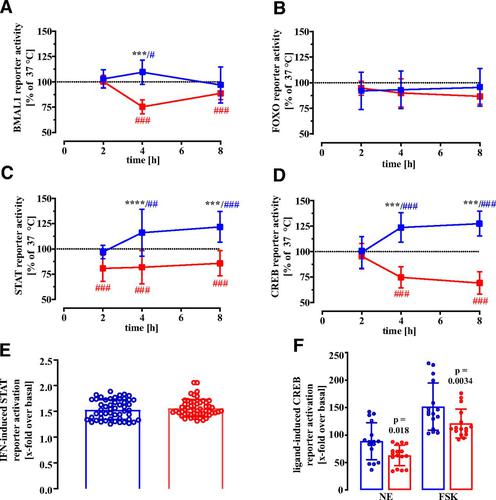当前位置:
X-MOL 学术
›
Mol. Pharmacol.
›
论文详情
Our official English website, www.x-mol.net, welcomes your
feedback! (Note: you will need to create a separate account there.)
Physiological Temperature Changes Fine-Tuneβ2- Adrenergic Receptor-Induced Cytosolic cAMP Accumulation
Molecular Pharmacology ( IF 3.2 ) Pub Date : 2021-09-01 , DOI: 10.1124/molpharm.121.000309 Dennis Faro 1 , Ingrid Boekhoff 1 , Thomas Gudermann 1 , Andreas Breit 2
Molecular Pharmacology ( IF 3.2 ) Pub Date : 2021-09-01 , DOI: 10.1124/molpharm.121.000309 Dennis Faro 1 , Ingrid Boekhoff 1 , Thomas Gudermann 1 , Andreas Breit 2
Affiliation

|
Norepinephrine (NE) controls many vital body functions by activating adrenergic receptors (ARs). Average core body temperature (CBT) in mice is 37°C. Of note, CBT fluctuates between 36 and 38°C within 24 hours, but little is known about the effects of CBT changes on the pharmacodynamics of NE. Here, we used Peltier element–controlled incubators and challenged murine hypothalamic mHypoA -2/10 cells with temperature changes of ±1°C. We observed enhanced NE-induced activation of a cAMP-dependent luciferase reporter at 36 compared with 38°C. mRNA analysis and subtype specific antagonists revealed that NE activates β2- and β3-AR in mHypoA-2/10 cells. Agonist binding to the β2-AR was temperature insensitive, but measurements of cytosolic cAMP accumulation revealed an increase in efficacy of 45% ± 27% for NE and of 62% ± 33% for the β2-AR–selective agonist salmeterol at 36°C. When monitoring NE-promoted cAMP efflux, we observed an increase in the absolute efflux at 36°C. However, the ratio of exported to cytosolic accumulated cAMP is higher at 38°C. We also stimulated cells with NE at 37°C and measured cAMP degradation at 36 and 38°C afterward. We observed increased cAMP degradation at 38°C, indicating enhanced phosphodiesterase activity at higher temperatures. In line with these data, NE-induced activation of the thyreoliberin promoter was found to be enhanced at 36°C. Overall, we show that physiologic temperature changes fine-tune NE-induced cAMP signaling in hypothalamic cells via β2-AR by modulating cAMP degradation and the ratio of intra- and extracellular cAMP.
中文翻译:

生理温度变化微调β2-肾上腺素受体诱导的胞浆cAMP积累
去甲肾上腺素 (NE) 通过激活肾上腺素能受体 (AR) 来控制许多重要的身体功能。小鼠的平均核心体温 (CBT) 为 37°C。值得注意的是,CBT 在 24 小时内在 36 至 38°C 之间波动,但关于 CBT 变化对 NE 药效学的影响知之甚少。在这里,我们使用帕尔贴元件控制的培养箱,并以 ±1°C 的温度变化挑战小鼠下丘脑 mHypoA -2/10 细胞。我们观察到,与 38°C 相比,36°C 时 NE 诱导的 cAMP 依赖性荧光素酶报告基因激活增强。 mRNA 分析和亚型特异性拮抗剂表明 NE 激活 mHypoA-2/10 细胞中的β 2 - 和β 3 -AR。激动剂与β 2 -AR 的结合对温度不敏感,但对胞质 cAMP 积累的测量显示,在 36 ℃ 时,NE 的功效增加了 45% ± 27%, β 2 -AR 选择性激动剂沙美特罗的功效增加了 62% ± 33% °C。当监测 NE 促进的 cAMP 流出时,我们观察到 36°C 时绝对流出增加。然而,在 38°C 时,输出的 cAMP 与胞质中积累的 cAMP 的比率较高。我们还在 37°C 下用 NE 刺激细胞,然后在 36°C 和 38°C 下测量 cAMP 降解。我们观察到 38°C 时 cAMP 降解增加,表明较高温度下磷酸二酯酶活性增强。与这些数据一致,NE 诱导的甲状腺激素启动子激活在 36°C 下增强。总的来说,我们发现生理温度变化通过调节cAMP降解以及细胞内和细胞外cAMP的比例,通过β 2 -AR微调下丘脑细胞中NE诱导的cAMP信号传导。
更新日期:2021-09-08
中文翻译:

生理温度变化微调β2-肾上腺素受体诱导的胞浆cAMP积累
去甲肾上腺素 (NE) 通过激活肾上腺素能受体 (AR) 来控制许多重要的身体功能。小鼠的平均核心体温 (CBT) 为 37°C。值得注意的是,CBT 在 24 小时内在 36 至 38°C 之间波动,但关于 CBT 变化对 NE 药效学的影响知之甚少。在这里,我们使用帕尔贴元件控制的培养箱,并以 ±1°C 的温度变化挑战小鼠下丘脑 mHypoA -2/10 细胞。我们观察到,与 38°C 相比,36°C 时 NE 诱导的 cAMP 依赖性荧光素酶报告基因激活增强。 mRNA 分析和亚型特异性拮抗剂表明 NE 激活 mHypoA-2/10 细胞中的β 2 - 和β 3 -AR。激动剂与β 2 -AR 的结合对温度不敏感,但对胞质 cAMP 积累的测量显示,在 36 ℃ 时,NE 的功效增加了 45% ± 27%, β 2 -AR 选择性激动剂沙美特罗的功效增加了 62% ± 33% °C。当监测 NE 促进的 cAMP 流出时,我们观察到 36°C 时绝对流出增加。然而,在 38°C 时,输出的 cAMP 与胞质中积累的 cAMP 的比率较高。我们还在 37°C 下用 NE 刺激细胞,然后在 36°C 和 38°C 下测量 cAMP 降解。我们观察到 38°C 时 cAMP 降解增加,表明较高温度下磷酸二酯酶活性增强。与这些数据一致,NE 诱导的甲状腺激素启动子激活在 36°C 下增强。总的来说,我们发现生理温度变化通过调节cAMP降解以及细胞内和细胞外cAMP的比例,通过β 2 -AR微调下丘脑细胞中NE诱导的cAMP信号传导。











































 京公网安备 11010802027423号
京公网安备 11010802027423号